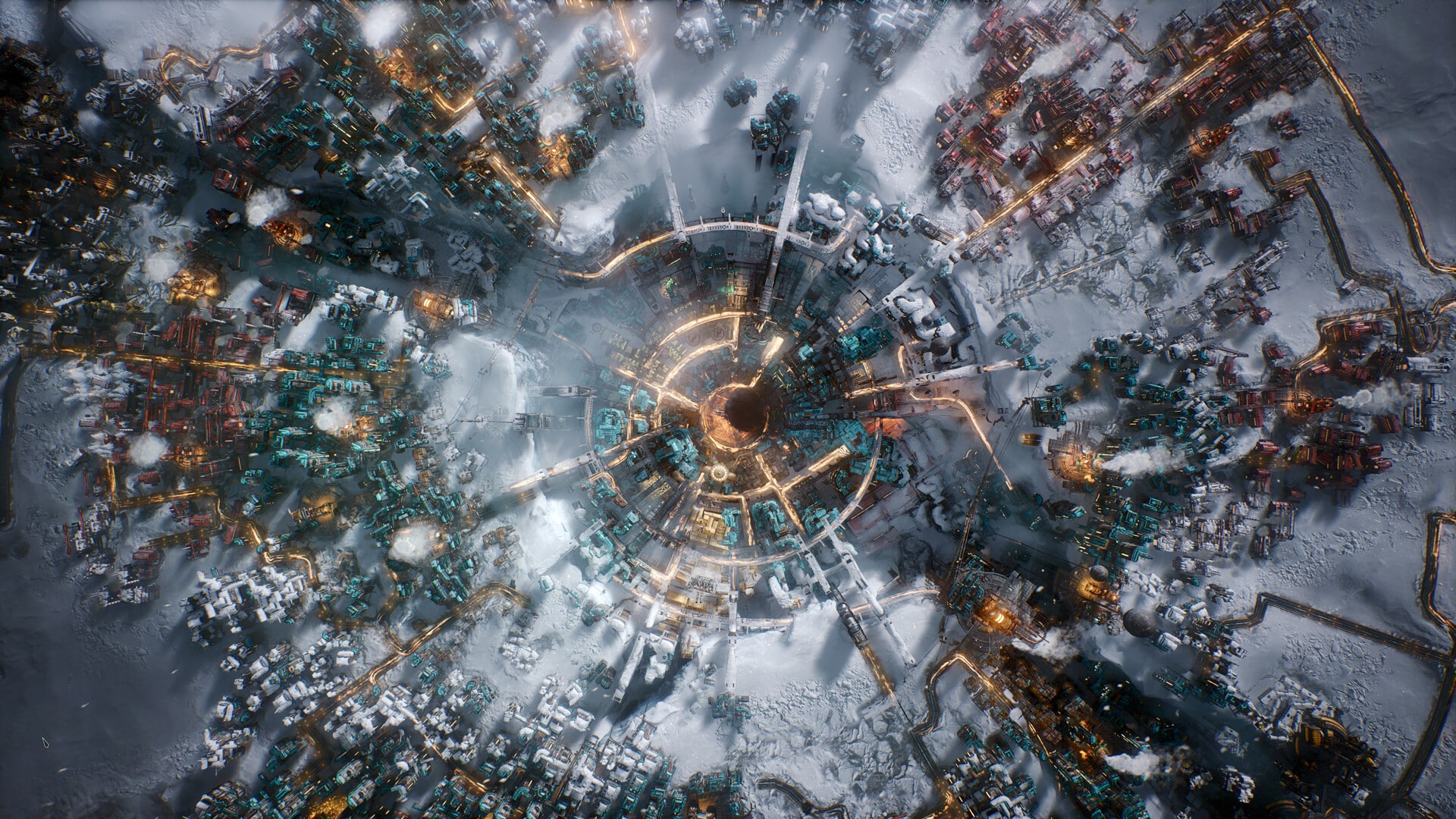
Updated May 30, 2017: We've refreshed this list to ensure all information is still relevant now that Gwent has moved from closed to public beta.
Gwent: The Witcher Card Game is a standalone version of the wildly popular minigame from The Witcher 3: Wild Hunt. While it draws many similarities to its older sibling, it has been fine-tuned and adapted to fit into its new role. To help you deal with the stiff competition in the public beta, we've compiled some great gameplay tips and tricks.
Take part in the public beta at PlayGwent.com
- What is Gwent?
- A fistful of cards
- Building a Gwent deck
- How to win a game of Gwent
- Leveling up, kegs, and crafting
- Meteorite powder, premium cards, and trinkets
- A few more tips and tricks to help you succeed at Gwent
What is Gwent?
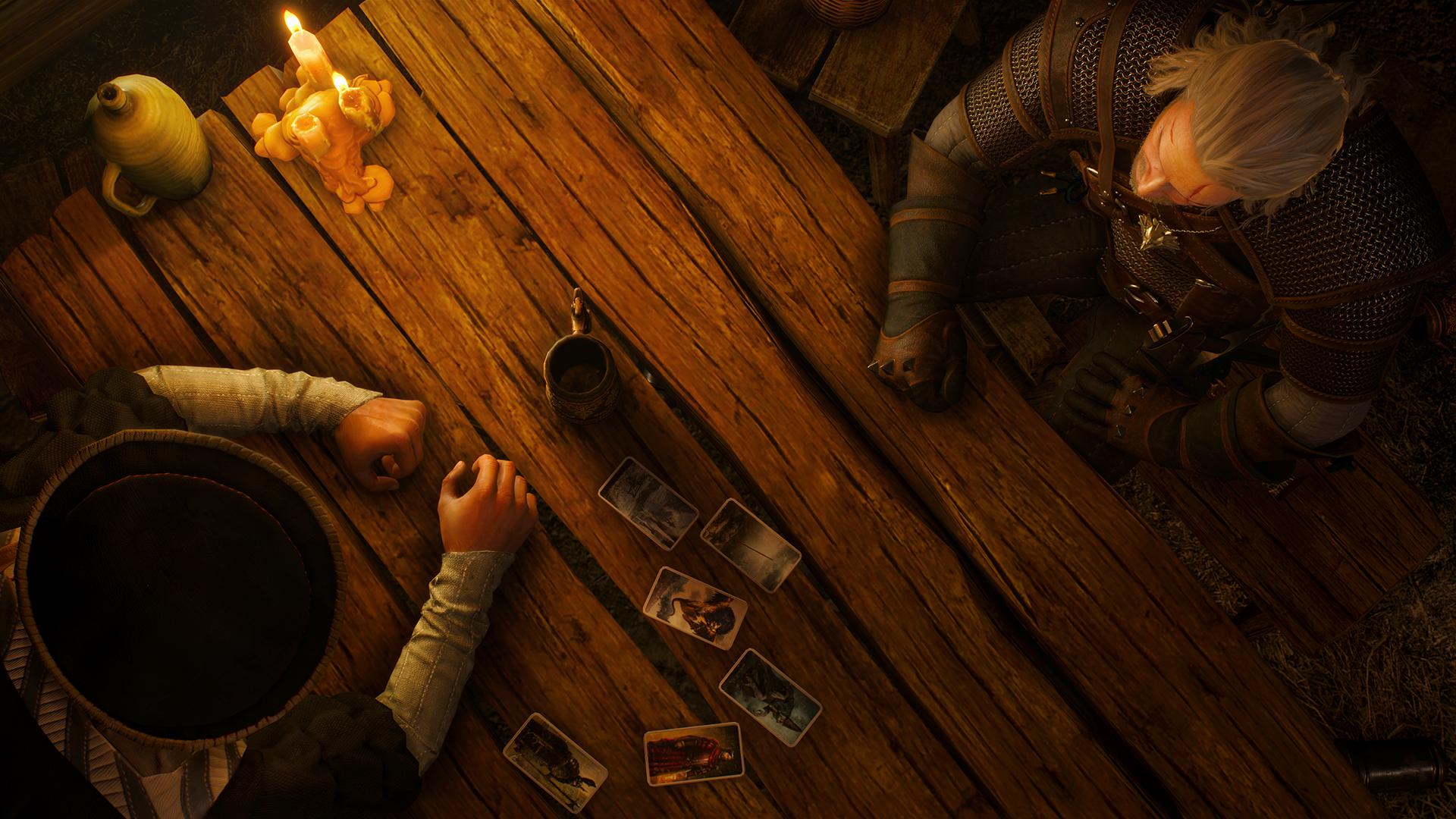
Gwent is an Xbox Play Anywhere collectible card game that supports cross-platform play between Xbox One and Windows 10. The nut of the game is that it lets you build your own decks from a base of starter cards and any cards you've crafted or collected from booster packs. In Gwent, these packs are known as kegs.
As you progress through the leveling system, you will collect ore, scraps, and meteorite powder. Ore is used to purchase kegs — you can also use real cash — and scraps are used to craft new cards. Meteorite powder is used for premium cards. Once you have a deck you think can stand up to competition, it's time to take it online. Play in a casual match for bragging rights and resources, or jump into a ranked match and begin your journey to the top of the Gwent leaderboard.
Check out our first impression of Gwent: The Witcher Card Game
A fistful of cards
Gwent's cards are spread out over four factions based on The Witcher 3's world, plus there is a neutral category for cards that don't fit into a faction.
Get the Windows Central Newsletter
All the latest news, reviews, and guides for Windows and Xbox diehards.
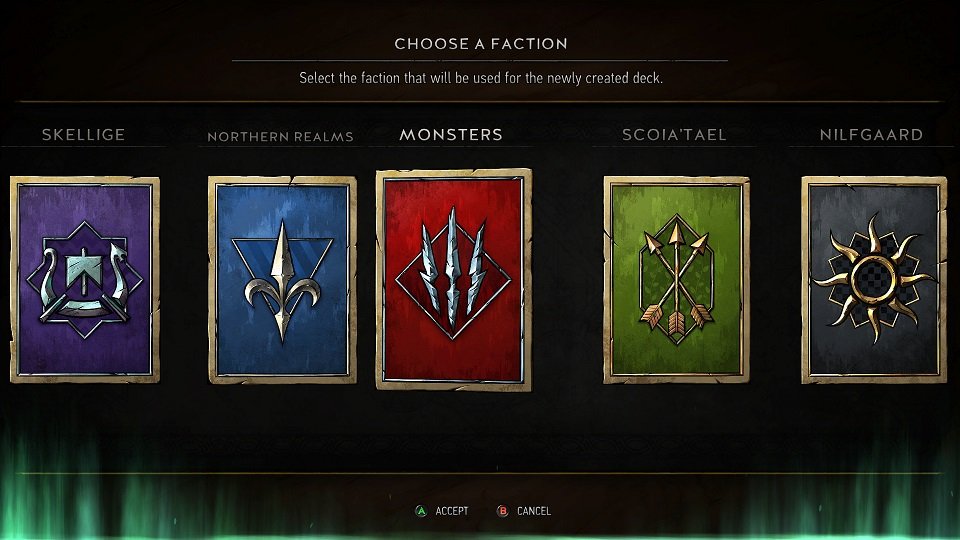
- Neutral: These cards include weather effects, special power-ups, Witchers, dragons, mages, dwarves, and any other characters that don't necessarily fit into a faction — yes, this category includes Geralt's horse, Roach.
- Monsters: Here you'll find members of the Wild Hunt, harpies, nekkers, golems, griffins, cranes, and any other horrible figures that Witchers usually kill to make a living. This deck is great at manipulating the weather, playing the graveyard and creating enormous armies.
- Nilfgaard: Expect to find siege engines, mages, heroes of Nilfgaard, and even some Witchers. This deck relies on espionage and being able to see your foe's plan before it can be deployed.
- Northern Realms: Foltest's empire includes plenty of siege engines, foot soldiers, commanders, cavalry, and some of the most iconic figures from The Witcher 3: Wild Hunt. Promoting lots of weak infantry and bolstering them with siege engines and other power-ups is the premise of this deck.
- Scoia'tael: Rogue elves and dwarves come together to make up this deck. You'll find mercenaries, sappers, marksmen, and plenty of heroes, including Zoltan Chivay. Strength is gained from playing card combinations, and plenty of cards can be recycled through rounds.
- Skellige: Likened to Vikings, the Skellige deck involves a lot of hearty infantry, berserkers, shapeshifters, and longships. Skellige decks work better as they take damage, and there is plenty of opportunity for resurrection.
Decks you build can be fine-tuned to your heart's content, and the wide variety of cards allows for almost endless combinations. It's highly likely that the best decks have yet to be discovered.
Building a Gwent deck
When you first begin the game, you'll have a few starter decks to play around with. These are great to learn the basics, but you'll almost immediately want to create your own deck.
The first step required is to choose a faction. Each faction has its own strengths and weaknesses, and you'll want to experiment with each one to find the best for how you play. You can't see your opponent before the match begins, so you want to create a deck that can compete against any faction.
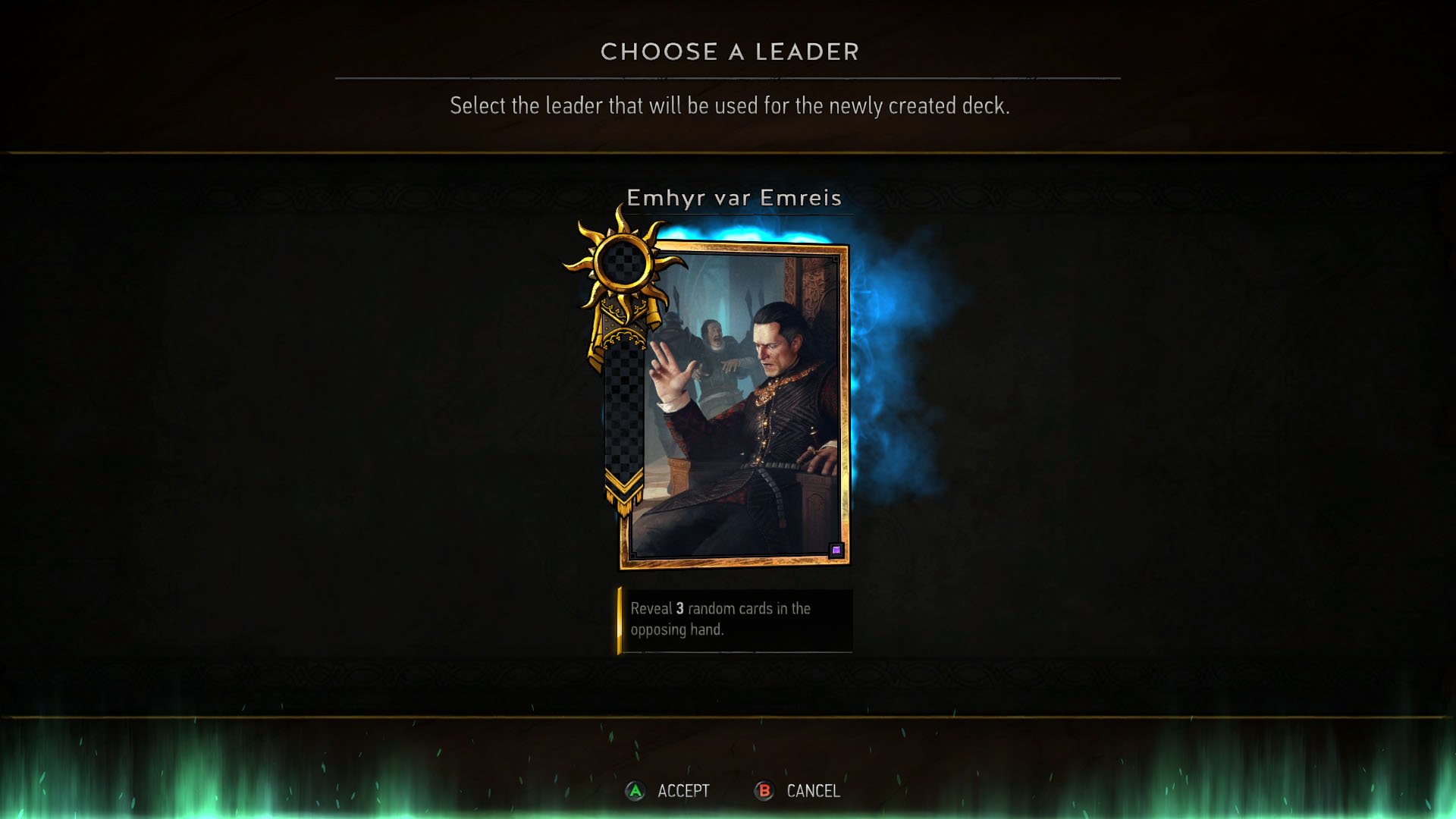
Next, you have to choose a leader. You'll likely only have one leader card for each faction to choose from at the start, but you'll eventually collect more from kegs or crafting. Each leader has a specific power that can be played during your turn. Using the leader's skill will finish your turn.
After choosing a leader, you want to start adding cards to your new deck. You can have up to four gold cards with no doubles, six silver cards with no doubles, and unlimited bronze cards with a maximum of three of the same card.
You can see what type of card it is by looking at the border. If there's any confusion as to which card belongs to which type, you can filter cards based on their color.
Cards also belong to one of six classes: infantry, ranged, siege, multi, spy, or special. The classes pertain to which row the card can be played on when it comes time to battle. The card's class can be verified by checking the icon near the top-left corner.

- Sword: This card belongs to infantry and can only be played on the infantry row.
- Crossbow: This card belongs to the ranged class and can only be played on the ranged row.
- Catapult: This card belongs to the siege class and can only be played on the siege row.
- Cycle arrows: This card belongs to the multi-class and can be played in any row.
- Icon with red eye: This card will be played on the enemy's side of the board on the corresponding row, usually with additional benefits.
- No icon: This is a special card and is played once before being discarded — it does not belong to any row.
Some cards will now have a set number of armor that must be depleted before their strength number is affected. This number is not noted visibly on the card, but is mentioned in the card's description.
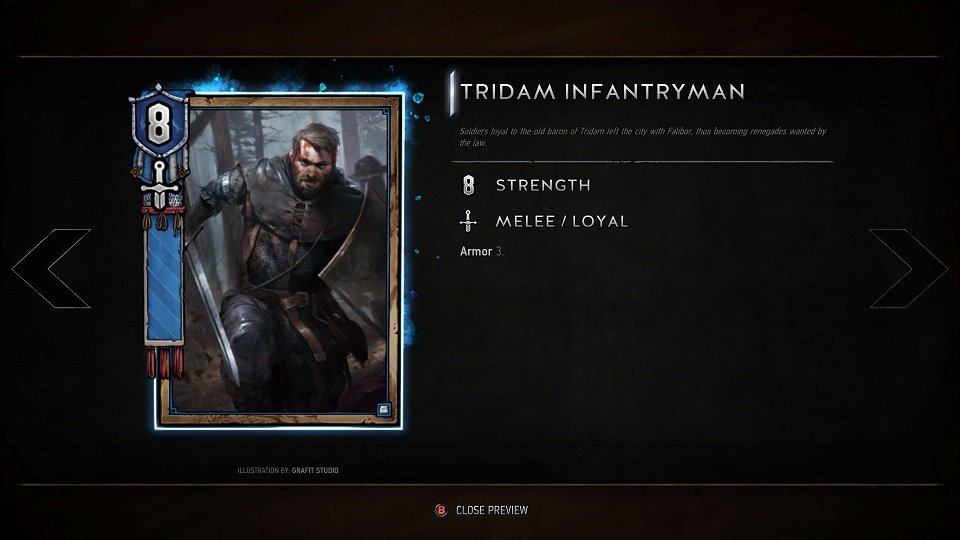
There are also sub-classes for some cards. These cards have a secondary icon below the class icon.
- Cracked skull: A special move is triggered when this card is removed from the battlefield.
- Fiery shield: This card has an extra power, including gaining power when certain other cards are played or immunity to certain effects. The power is mentioned below the card on the right side of the screen.
- Shield with a number: This card has an effect triggered when the number of turns displayed on the shield has passed.
As you build, you'll see whether or not you've met the requirements for a legal deck. You must have at least 25 cards in a deck, and you cannot have any more than 40 cards. A "Ready to play!" message will appear in the top-left corner of your screen when you've created a legal deck.
Save and exit when you're satisfied, and you'll be able to play with your newly created deck. You can use the same cards from your collection in as many decks as you want.
Read more about how to create a great deck in Gwent
How to win a game of Gwent
The first thing to do when you start a match is to discard any cards you don't want in your hand and draw fresh from your deck. You can discard and redraw up to three cards, and you can do that one card at a time if you so desire. If you're happy with the cards in your hands, you don't have to discard any and can move right along.
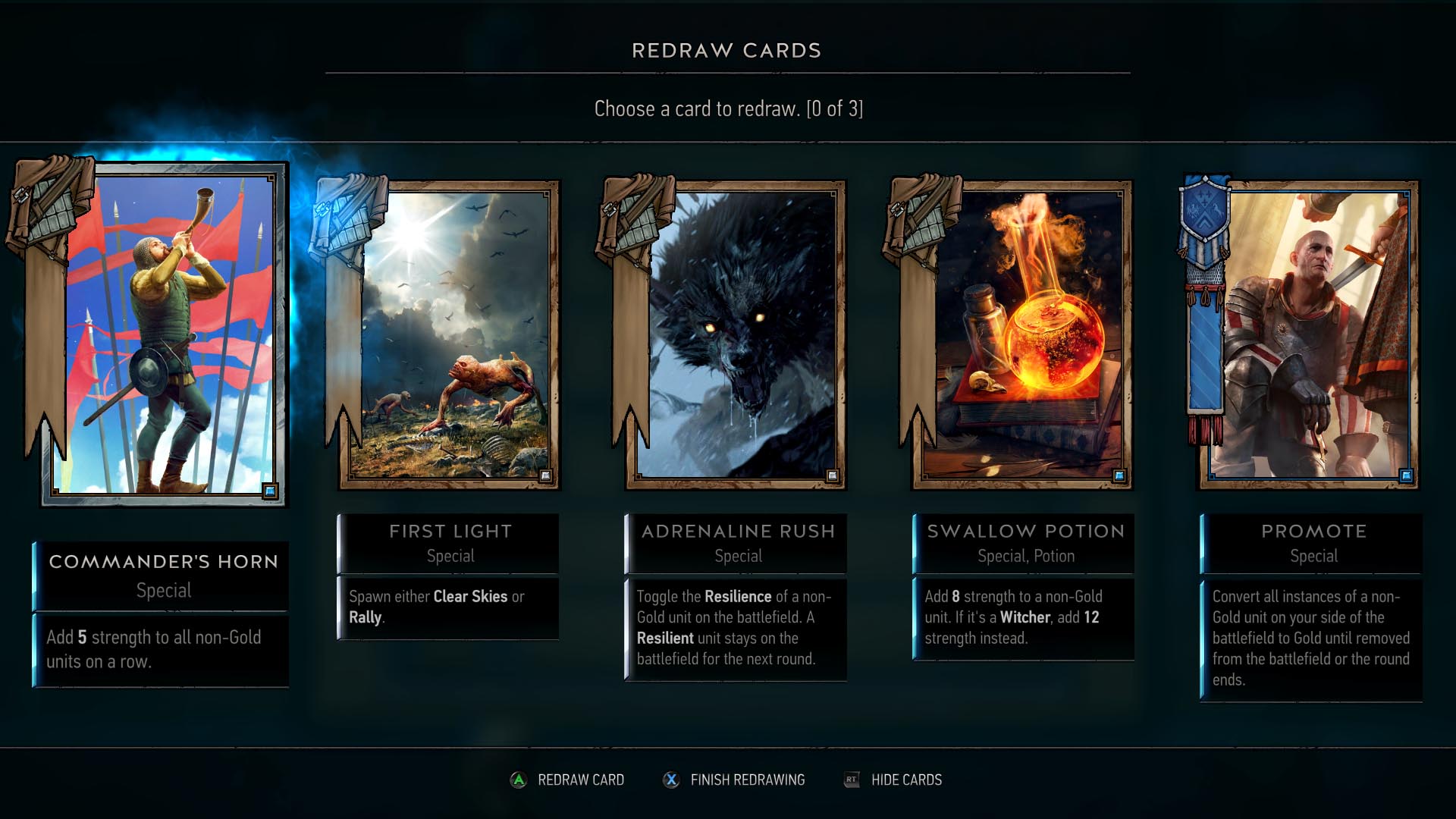
Once you're finished redrawing, a coin will flip to determine who goes first. When it's your turn, you can either play a card or pass your turn. Once you pass once, you will continue passing turns until your opponent also passes or runs out of cards in-hand. Only pass when you're certain you've won the round or it applies to your strategy. Remember, the first to win two rounds wins the match, so passing too early can be a big mistake.
Once you play a card, the turn will pass to your opponent. It will go back and forth until one of you runs out of cards, or both of you pass. The player with the higher count — this number can be found next to your name in the bottom-left corner of the screen — will win the round. This number is the sum of the strength of all your cards currently in play.
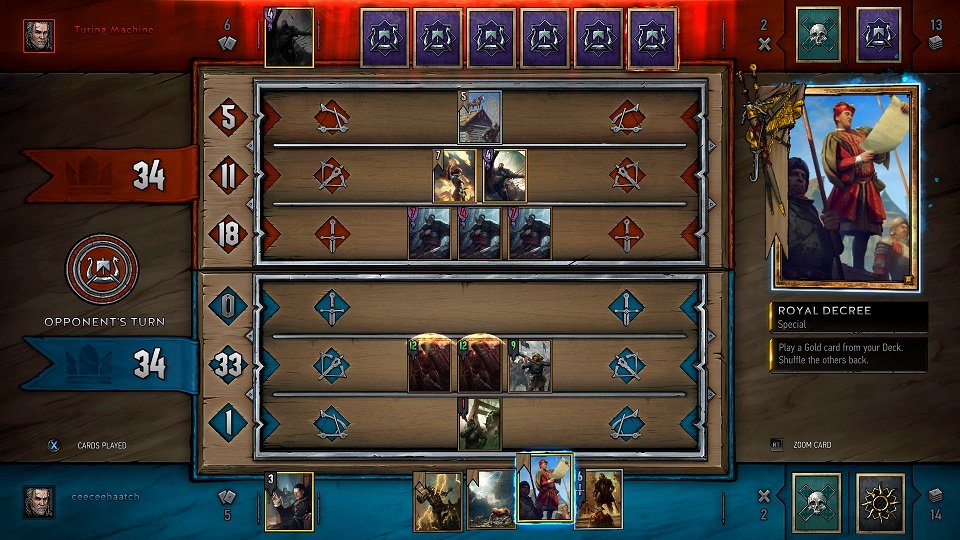
At the start of the second round, two cards will be drawn into your hand. You can choose to redraw one card. If there is a third round, a single card will be drawn into your hand. You can also, at this point, choose to redraw one card. Keep this in mind when using cards or attempting to exhaust your opponent's hand.
An update to how cards are placed in a row
In early versions of the Gwent closed beta, placing cards on rows was as easy as picking a row. Not so much anymore. When placing a card, you can now choose where it goes on the row in relation to other cards already in play. This is a pretty big change, and coincides with adjustments to how a lot of cards work. Whereas before a card's special ability might affect an entire row, it might now affect only the cards directly adjacent.
A few words on bluffing
Depending on the deck you're playing, there is an incredibly deep pool of strategies to choose from. As you gain experience, you'll begin to see that bluffing plays a huge part in Gwent. One of the most popular strategies involves intentionally playing some big cards right off the bat to get your opponent to play their heavy hitters, in which case you throw the round by passing. This depletes the enemy's hand, but can backfire if you can't make up for the pass by winning two rounds in a row. No matter how you choose to play, you must win two rounds to win the match.
Leveling up, kegs, and crafting
When you win a match, you'll gain a bar of XP toward the next level. You'll also collect a small amount of ore or scraps for each small bar — when you level up by filling all bars, you'll collect a way larger amount of resources that can be used for crafting or for purchasing kegs.
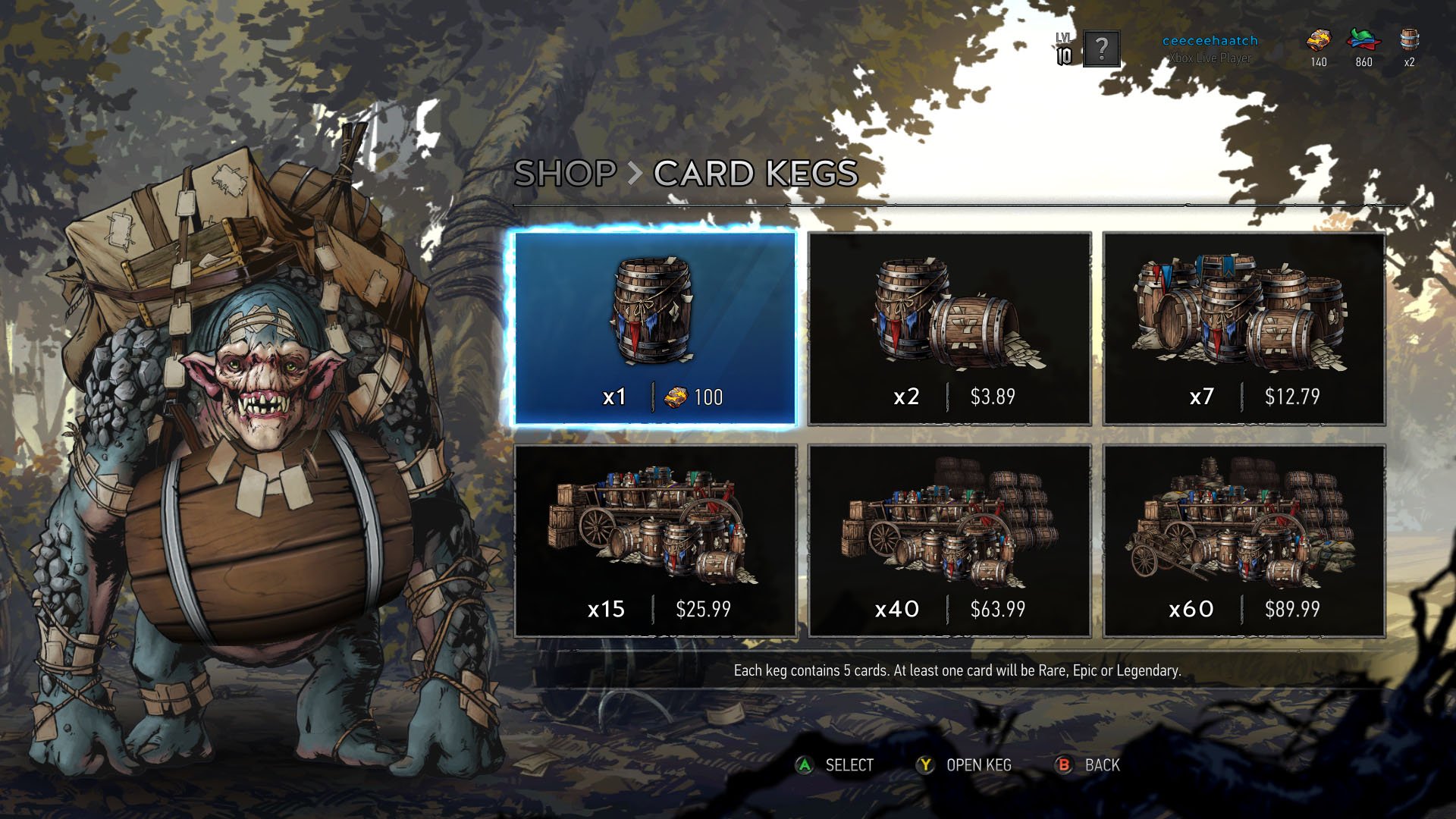
To purchase a keg with either ore or real money, visit the shop and click a keg. Each keg costs 100 ore and has five cards within, where at least one card will be a rare, epic, or legendary. You're shown four overturned cards that you flip over one at a time — the suspense! — before choosing a fifth card. All five cards will be added to your collection.
Buying kegs isn't the only way to add cards to your collection. If you navigate to the actual Collection page within Gwent, you can view all cards whether or not they're in your collection.
Why show all cards? You can craft any card you want as long as resources allow. When highlighting a card, you'll be shown how many scraps it takes to craft, as well as how many scraps you'll receive if you mill a copy. Select the card and hit Craft in order to create this card.
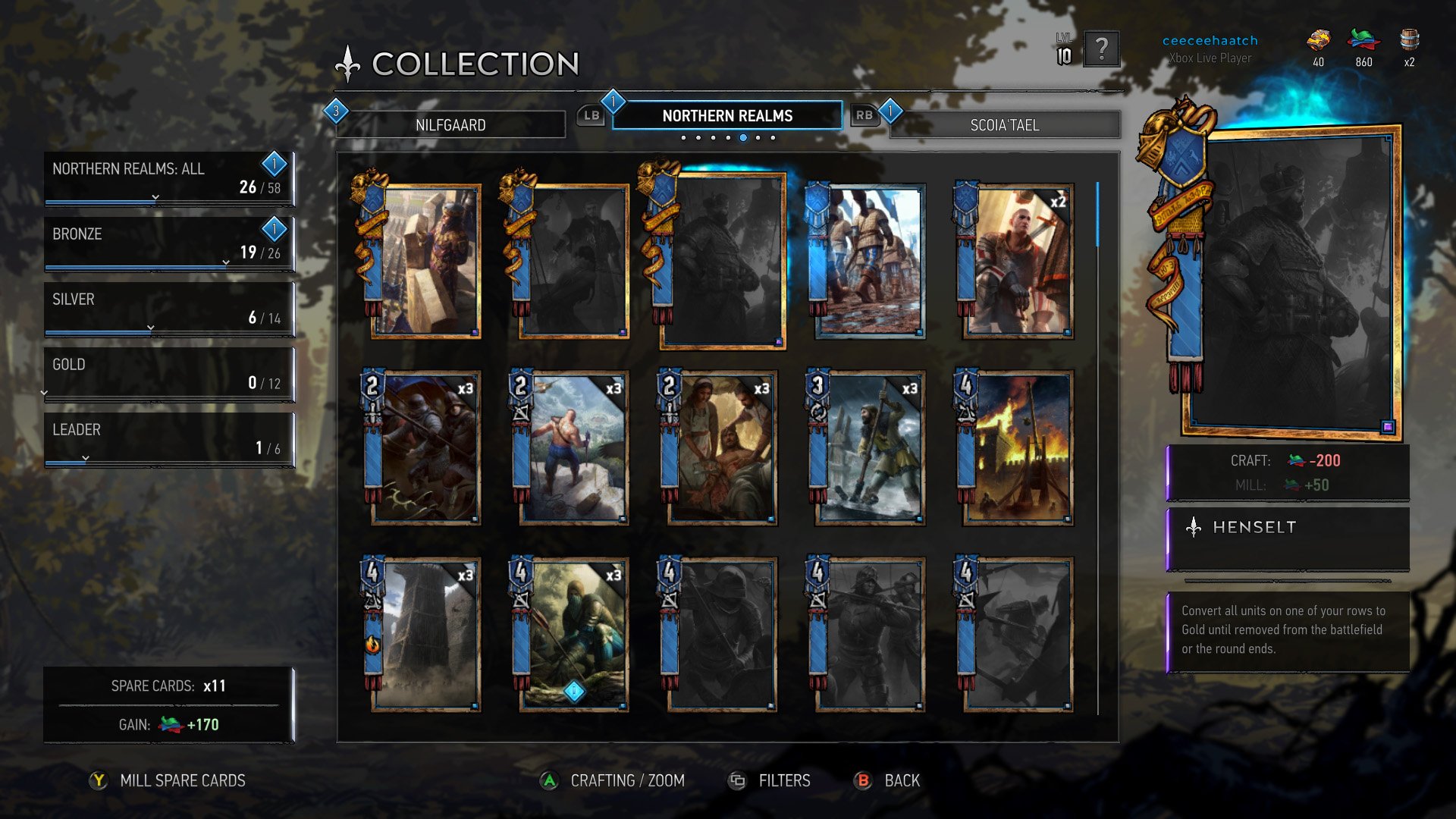
Any cards you don't think you'll use — especially if you have more than three copies of the same card — can be milled into scraps. There is a smart-mill function that will get rid of unnecessary duplicates for you, and shows you how many scraps you'll receive if you choose to mill all your spare cards.
Meteorite powder, premium cards, and trinkets
Meteorite powder is a currency available alongside ore and scraps. It can be collected by playing matches, by purchasing with real cash, or by milling premium cards. What are premium cards? They are normal cards that are converted with Meteorite powder. Premium cards are the same as regular cards function-wise, except they have an animated graphic and new sound bite.
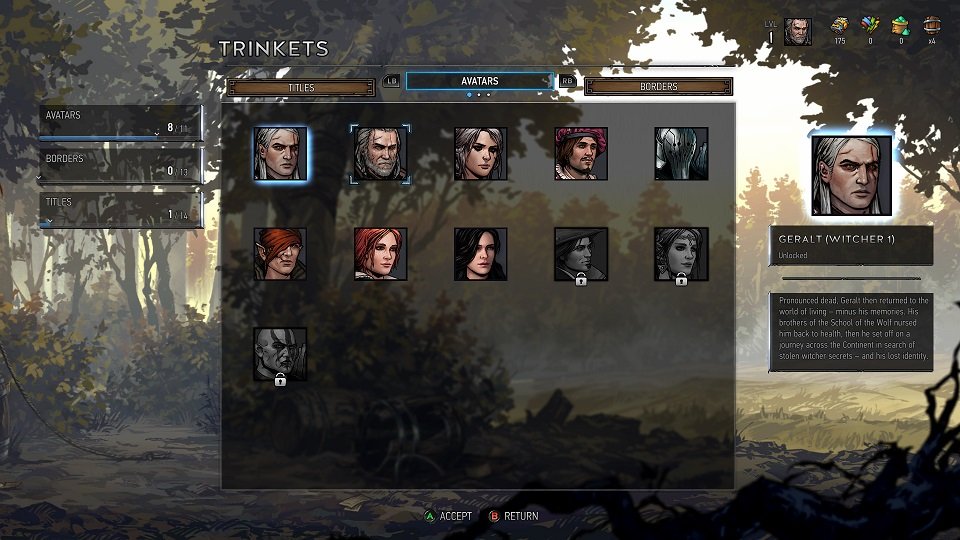
A Trinkets section can be found under the Cards tab in the main menu. Here you can choose your avatar, you can choose a border to place around your avatar, and you can choose a title for yourself. These are strictly vanity items and are unlocked by reaching certain ranks or by placing in a certain position during seasonal play.
A few more tips and tricks to help you succeed at Gwent
There are a few more general tips and tricks that deserve mention when it comes to learning how to play Gwent.
- Don't mill decks you don't play with. It might be a little tempting, especially when you're first starting out, but milling most or all of a deck's cards will come back and bite you. It is incredibly difficult to build a deck from scratch, and you'll likely, at some point, want to try out every faction.
- Don't be afraid to mill spare cards. You can only use three copies of the same card in a deck, so having more is a waste. Use the smart-mill function or mill extra cards on your own. Remember, the same cards can be used in as many decks as you want at the same time.
- Take account of weather effects when placing cards. Frost affects the infantry row, fog affects the ranged row, and rain affects the siege row. It's never a bad idea to spread out your troops over all three rows or keep a First Light card in your deck to wipe weather from the battlefield.
- Try to keep the number of cards in your hand as low as possible. Yes, you can cram up to 40 cards into a hand, but the best cards will be buried among the weak cards.
- Don't be afraid to practice against real players in casual matches before moving to ranked matches. The AI is a decent opponent, but the real challenge rests in human intelligence.
- Always plan a few moves in advance. Like chess, you want to have an idea of where your opponent is going, and want to have a contingency plan no matter how your opponent plays.
- Plan for the future by looking into the past. A move history is available for you to check at any point during an ongoing match. Can't remember if you already played a certain card? Look it up!
- Don't get discouraged! Even if you lose a lot, you're learning the ins and outs of each deck. It takes time to get good at Gwent.
- Communicate with your opponent. A Taunt feature lets you shoot short phrases back and forth over the board, which was previously completely silent. There are both sides of a coin here: hostility and friendliness.
- Complete challenges as an easy way to get ore, scraps, and other goodies.
- Get involved with the community. Gwent has a vibrant community on reddit.com/r/gwent, and this is where you will learn a lot of the strategies for more advanced play.

Cale Hunt brings to Windows Central more than eight years of experience writing about laptops, PCs, accessories, games, and beyond. If it runs Windows or in some way complements the hardware, there’s a good chance he knows about it, has written about it, or is already busy testing it.
